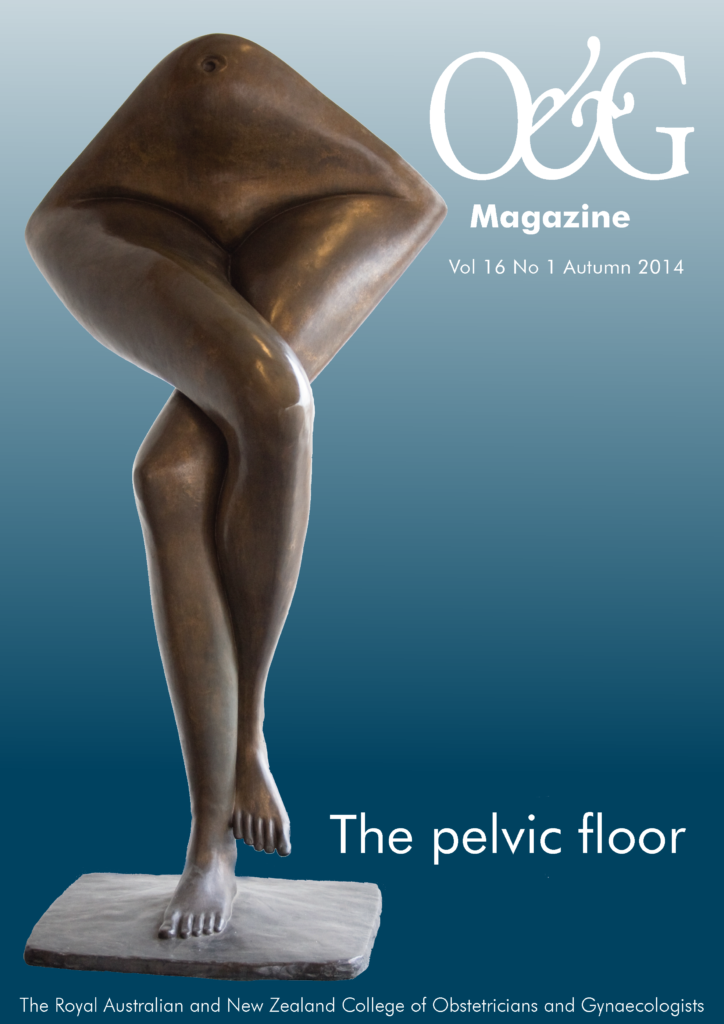In the community, there is a wide range of opinion regarding the place of the episiotomy in the care of women. Thus, it is important we continuously re-evaluate our practice in a woman-centred approach, so we can communicate both the potential benefit and risk involved with episiotomy.
The incidence of episiotomy has reduced in the past two decades in Australia, with a change toward restricted over routine episiotomy. Even so, 35 per cent of primiparous Australian women having a vaginal birth underwent episiotomy in 2012.1
Indications for episiotomy
The recent trend in Australia has been away a routine use of episiotomy in favour of restrictive use. This transition came from evidence showing restrictive policy to be associated with less posterior perineal trauma, less suturing and fewer healing complications as compared to routine episiotomy.2 Importantly, no difference was found between restrictive and routine episiotomy in rates of severe lacerations, dyspareunuria, urinary incontinence or pain measurements.2,3 Restrictive episiotomy is, however, associated with more anterior perineal traumas.2
As per the RANZCOG College Statement, episiotomy should be considered where there is:
- a high likelihood of severe laceration;
- soft tissue dystocia;
- a requirement to accelerate the birth delivery of a compromised fetus;
- a need to facilitate operative vaginal delivery; or
- a history of female genital mutilation.4
Operative vaginal delivery is one instance in which the decision of whether to employ episiotomy or not must be made on a case-by-case basis, using well-considered clinical judgement. The literature is unclear as to whether a routine episiotomy in this setting is advisable. Retrospective cohort studies have demonstrated significant risk reduction of obstetric anal sphincter injury (OASIS) with routine episiotomy during operative vaginal delivery.5 One study went so far as to estimate one OASIS injury could be prevented by routine episiotomy in every 12 vacuum deliveries and five forceps deliveries.6 Conversely, another did not find altered risk of OASIS in restrictive versus routine episiotomy.7
Mediolateral episiotomy
In Australia, the type of episiotomy most commonly performed is mediolateral. This is described as an incision made under appropriate analgesia, 3–5cm in length from the fourchette at an angle 60–80 degrees to the midline at the time of distension of the perineum by the presenting part. After delivery, the angle becomes 45 degree from midline. Anatomical structures cut include: vaginal epithelium; transverse perineal and bulbocavernosus muscles; and perineal skin. The mediolateral episiotomy is preferred over medial episiotomy as it is associated with lower rates of OASIS injuries.8-10 It is also preferred over a lateral episiotomy, which is associated with more suturing and longer repair times, but no reduction in OASIS injury.11
The pelvic floor and incontinence
The impact of episiotomy on the pelvic floor is debatable. Recent studies have evaluated both quantifiable assessment of pelvic floor function and impact on women, however, findings are conflicting.
A study comparing women with mediolateral episiotomy to women with spontaneous laceration or intact perineum at three months postpartum found significantly lower values in pelvic floor strength on digital test and vaginal manometry in the episiotomy group. However, no difference in incontinence or prolapse was found.12
A number of studies have found no impact of episiotomy on the pelvic floor. A recent study found no difference in overall pelvic organ prolapse quantification (POP-Q) assessment at six months postpartum in women who had episiotomy versus those with spontaneous lacerations.13 Furthermore, pelvic floor function at five to ten years after birth of first child was assessed using a subjective questionnaire and POP-Q assessment. The authors found forceps deliveries and perineal lacerations, but not episiotomies, were associated with pelvic floor disorders (classified as overactive bladder, stress incontinence, prolapse beyond the hymen).14 Episiotomy was also shown not to be associated with avulsion of the levator ani at its pubic insertion on 4D ultrasound scan.15
Pain and dyspareunia
Perineal pain is a common experience for women in the immediate postpartum period after vaginal birth.17 Intensity of pain in the first week postpartum is be related to degree of perineal trauma.17 Yet the effect of episiotomy versus spontaneous perineal laceration on long-term pain is unclear. Some have found no difference in pain at six-weeks postpartum between episiotomy and spontaneous laceration.17,18 However, others have documented significantly higher rates of perineal pain and dyspareunia at three months in women with mediolateral episiotomy.12
As in all aspects of our clinical practice, we aim to provide the best outcome for both mother and baby. Episiotomy is one of the most commonly performed surgical interventions, yet research is still needed to fully evaluate its risks and benefits in different clinical scenarios. It is important that we communicate clearly to women when deciding to perform an episiotomy so they can participate in their own healthcare in an informed way. Given the time-pressured environment in which most deliveries occur, we must recognise that this will represent an ongoing challenge for obstetricians and midwives alike.
References
- Australasian clinical indicator report 2005-2012, 14th Edition. Sydney, Australia, ACHS; 2013.
- Carroli G, Mignini L. Episiotomy for vaginal birth. Cochrane Database of Systematic Reviews 2009, Issue 1.
- Hartmann K, Viswanathan M, Palmierei Re t al. Outcomes of routine episiotomy; a systematic review. JAMA. 2005; 293:2141.
- Routine Intrapartum Care in the absence of pregnancy complications. RANZCOG College Statement C-Obs 31 March 2011.
- de Vogel J, van der Leeuw-van Beek A, Gietelink D, et al. The effect of a mediolateral episiotomy during operative vaginal delivery on the risk of developing obstetrical anal sphincter injuries. Am J Obstet Gynecol. 2012; 206:404.e1.
- de Leeuw JW, de Vit C, Kujken JP, Bruinse HW. Mediolateral episiotomy reduces the risk for anal sphincter injury during operative vaginal delivery. BJOG. 2008; 115:104.
- Murphy DJ, Macleod M, Bahl R, Goyder K, Howarth L, Strachan B. A randomised controlled trial of routine versus restrictive episiotomy at operative vaginal delivery: a multicentre pilot study. BJOG. 2008 115(13): 1695-702.
- Coats PM, Chan KK, Wilkins M, Beard RJ. A comparison between midline and mediolateral episiotomies. BJOG. 1980; 87:408
- Shiono P, Klebanoff MA, Carey JC. Midline episiotomies: more harm than good? Obstet Gynaecol. 1990; 75:765.
- Klein MC, Gauthier RJ, Jorgensen SH, Robbins JM, Kaczorowski J, Johnoson B et al. Does episiotomy prevent perineal trauma and pelvic floor relaxation. Am J Obstet Gynecol. 1994, 171:591.
- Karbanova J, Rusavy Z, Betincova L, et al. Clinical evaluation of peripartum outcomes of mediolateral versus lateral episiotomy. Eur J Obstet Gynaecol Reprod Biol. 2014; 173:34-7.
- Sartore A, De Seta F, Maso G, et al. The effects of mediolateral episiotomy on pelvic floor function after vaginal delivery. Obstet Gynecol. 2004; 103:669.
- Aytan H, Tok EC, Ertunc D, Yasa O. The effect of episiotomy on pelvic organ prolapse assessed by pelvic organ prolapse quantification system. Eur J Obstet Gynecol Reprod Diol. 2013 Nov 23.
- Handa VL, Blomquist JL, McDermott KC, Friedman S, Munox Z. Pelvic floor disorders after vaginal birth: effect of episiotomy, perineal laceration, and operative birth. Obstet Gynecol. 2012 Feb; 119(2 Pt 1):233-9.
- Cassado J, Pessarrodona A, Rodriguez-Carballeira M, Hinojosa L et al. Does episiotomy protect against injury of the levator ani muscle. Neurourol Urodyn. 2013; Sep:5.
- East CE, Sherburn M, Nagle C, Said J, Forster D. Perineal pain following childbirth: Prevalence, effects on postnatal recovery and alagesia usage. Midwifery. 2012; 28:93-97.
- Macarthur AJ, Macarthur C. Incidence, severity and determinants of perineal pain after vaginal delivery: A prospective cohort study. Am J Obstet Gynecol. 2004; 191:1199.
- Langer B, Minetti A. Immediate and long term complications of episiotomy. J Gynecol Obstet Biol Reprod. (Paris) 2006 Feb; 35(1Suppl):1S59-1S67.






Leave a Reply